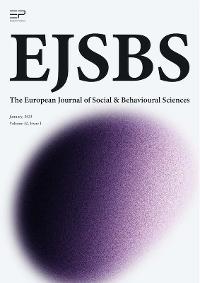Abstract
The socio-psychological situation in Ukraine has undergone significant changes. A global pandemic, harsh quarantine measures, war, insufficient public information, stigmatization of public opinion, high risks to public health – have all created a new psychosocial reality of life for both adults and young people. It is obvious that these problems and their manifestation in totality have affected young people’s life in various aspects. An anonymous voluntary survey of high school teachers conducted in 10 schools in different regions of Ukraine (Prykarpattia, Central and Northern) revealed a decrease in student activity (360 students aged 14-17) by 40% (attendance, willingness to learn and participate in educational activities), significantly reduced success (by 35%) during the distance learning period. The parents’ survey results show that young people’s feelings of fear (89%), anxiety (84%), aggression (58%), and depression (52%) are significant. A study of the structural characteristics’ of the specific manifestations of young people’s psychological potential was conducted between 2016-2020 which involved 2022 participants on a voluntary, anonymous basis. The young people’s psychological potential comprised the following components: motivational, emotional, value, and behavioral. The results showed a 40% decline in indexes on average over 2020-2021. A 4-stage young people’s psychological potential actualization model focusing on diagnostic, psycho-corrective, formative, and recreational-assertive aspects was developed based on the “Children`s Camp Zefir” recreation program and the adolescents’ psychological center “Alternative”. The model, implemented for the second year 2021-2022, currently displays significant results for increasing psychological indicators.
Keywords: adolescents, adolescents` personality life spheres, adolescents` psychological potential, psychological potential developing technology, psychological potential actualization
Introduction
Young people are the bedrock of the country`s future potential. It was they who drove the democratization processes, integration, and cross-cultural interaction. Today, the development of the younger generation of Ukrainians has been marked by turbulent processes of changes and transformations not only socio-politically and economically, but also socio-psychologically, culturally and internationally. The main problem and the main potential of the young people’s psychosocial development consists in opening a wide range of opportunities for development and self-realization, but at the same time in the lack of stability in the acquiring knowledge, abilities and skills sets to realize their own potential.
Young people’s family, school (and other social institutions like the church), peer reference groups, the environment (city, village, metropolis), mass media, national values and the country`s social system generally act as the main systems in the formation of the adult personality. Rapid changes in society destroy established values, norms, and customs, forcing people to quickly change and adapt to the information space, new moral norms, communication features and today`s psychosocial challenges.
The main social institution - the family - is undergoing a profound transformation associated with a change in its functional, status-role, and value-normative foundations. It is known that proper personality development includes the influence of older people on a young individual. When this is lacking, children communicate only with peers, narrowing the ways of growing up and sharing life experiences. Mark Bauerlein (2022), an American educator and author of the book The Dumbest Generation, suggests that peers influence is generally anti-intellectual and anti-historical because young people do not learn from their elders; but from the Internet and social media. Such influences can be detrimental to the psycho-social development of the young as self-confidence sometimes entails the search for not only fame, but also trouble.
Today, parents have practically lost control over their children’s free time. The family is rapidly losing its influence on children`s personality formation, in the process of mastering adulthood. Modern parents are confused, and, to make matters worse, in many educational systems and schools, approaches to personality formation are often incorrectly interpreted. Communication in the family is reduced to a friendly-partnership instead of a mentoring one; hence, levelling off the authoritative guidance of an adult.
The school`s influence on the younger generation socialization process is rapidly shrinking. Young people subconsciously are not engaged by the outdated education system, and they learn the skills that are relevant today on their own. All the necessary knowledge is available in the network, giving rise to many development directions. One can become a programmer, a cook, a musician, basically anything, at the age of 14. Young people are under the strongest natural factors` influence mentioned above. Although in the 21st century, it is difficult to call such factors spontaneous because we are dealing with a powerful, well-organized entertainment industry, transmitted around the clock by mass media and the Internet, offering ‘values’ that can be considered spiritually corrupt, morally bankrupt, and ugly mutations of normal human values.
Young people have become more obsessed on their inner “Me”, while trying to demonstrate it to others in every possible way, the more outrageous the better. According to Joel Stein, the “Times” journalist and author of The Me, Me, Me Generation (2013), today’s young generation are overly focused on their popularity and the opinions of peers. Some young people simply do not want to grow up; they remain “big kids” because social networks constantly stimulate the need for self-expression (the more outrageous the better) in order to attain approval by peers.
The information society has undermined the natural factors affecting children’s development (family, schools, church) and normalized valueless behaviors as the main influential factors for young people’s socialization disseminated by the mass media which has taken center stage as the primary component of young people’s socialization – replacing the traditional family, the school and the church.
Background of the Study
The foregrounding of the individual in the mass media culture and the media market`s emphasis on individualization have severely affected the developing social and emotional intelligence processes in the younger generation, inhibiting the attainment of young people’s psychological, social and emotional maturity processes while prolonging childhood which coincides with the continuous learning processes in the educational system while postponing professional achievement. Transferring the need for intimate and personal communication and recognition to the virtual space reduces or eliminates the need for face-to-face social relations and concurrent with that, the need to engage in respectful and proper behaviours when communicating and interacting with others. News and other types of messages are increasingly taking a visual form, rather than a textual one in the era of information overload. Teenagers like to look at pictures, photos, advertisements related to new products and fashion immersing them in this global movement which transforms them into customers and buyers simulataneously. This phenomenon is also related to the popularity of Internet memes - short picture-stories that can replace live emotions on the Internet.
One of the components of youth subculture is a gaming component, when a teenager plays a certain role. These roles tend to contain an “adventure gene” that promotes the release of adrenaline linked to danger, risk, and borderline stressful situations which is exactly what the young people relish in order to compensate for having to behave politely and correctly, and work on boring and painstaking school assignments. As a result, the range of emotions is narrowed, the communication system is simplified, and the protective mechanisms and self-awareness effects are all limited.
Research by the American social research center Wildness shows that 80% of today`s teenagers seek profit in their creativity, more than 25% publish their own original content, and 65% are engaged in the content`s distribution on social networks. At the same time, it is worth understanding that instant access to information can make teenagers somewhat vulnerable as they are exposed to global disasters in a matter of hours or even watch an online stream on their phone. So, it is not surprising that with the heightened reaction the news causes them, they seek their own escapism to ease their sense of despair from reality. Parental and family pressure usually does not help teenagers in the growing up process.
Only proper motivation and constant communication are tools to positively influence the younger generation as they are too immature to know what they want, but are already confidently approaching it. They are able to transform hobbies into work, develop mobile applications and create the future devices but lack the maturity to understand the boundaries.
Any crisis leads to the creation of new views, personality, attitudes, and even communication and interaction. Recently, the concept of competence has been actively included in the social and educational environment: key competence, educational competence, and life competence. Competence is the ability (potential) to perform complex activities. Competencies are distinguished by types such as key, basic and functional. Key competences are competences necessary for individuals to successfully navigate in a rapidly changing society.
What is meant here are “key” or life competencies which enables individuals to function effectively or competently in all spheres of life. So, the concept of key competence is an objective category that captures a socially determined complex of a requisite level of knowledge, abilities, skills, and attitudes that can be applied in any human activity based on the premise that such key competence will contribute to success in life, and correspondingly enhance the quality of the development of public institutions.
The Institute for the Future: Future Work Skills 2020 and the Partnership for the 21st Century Learning in trying to coordinate all efforts around helping to develop children’s personality; their comprehensive development and psychological support have adopted an impressive set of key competencies:
1) Collaboration -referring to the ability to productively engage in a group setting, both face-to-face and virtually building an awareness of self and of others to move a team forward along common values and goals.
2) Communication – referring to the balance of speaking and active listening, writing, and reading with a strong grasp on the verbal and non-verbal aspects of expression.
3) Critical thinking referring to the utilization of novel and adaptive thinking, coupled with analytical skills to generate creative solutions that positively impact society.
4) Cross cultural intelligence referring to the ability to navigate and operate in and adapt to a globally connected world acknowledging that a diverse team drives innovation and productivity.
5) Growth mindset referring to the resiliency, dedication, hard work, and belief in self to accomplish any task as well as the commitment to being a lifelong learner.
6) New media literacy and computational thinking referring to the ability to critically assess, navigate and create across diverse digital platforms as a strong grasp of this competency enhances effective communication and collaboration.
7) Self-expression referring to the ability to articulately share original thoughts and ideas in creative ways, while staying true to an authentic sense of self.
8) Self-directed learning referring to the demonstration of personal interests and the motivation to set goals and objectives to move those interests forward.
9) Servant Leadership referring to Robert Greenleaf’s Servant Leadership theory (Smith, C., 2005) which is based on a commitment to putting the good of a community and others before self-interests.
10) Social-emotional intelligence referring to the ability to accurately assess overt and covert social and linguistic cues since social-emotional intelligence is the foundation for effective collaboration and meaning-making.
The above key competences more holistically characterize the approach to the individuals’ comprehensive development and their successful navigation in modern society. This list factors in the comprehensive development of personality in terms of professional, social, and individual; enabling individuals the opportunity to reveal and realize their potential to successfully navigate adulthood.
In 2015, an experimental approach to developing key competencies was undertaken with teenagers in temporary young people associations, in particular in children's camps, taking into account the psychological science and practical psychology development aspect as a supporting and corrective component of the child upbringing and education modern system. This predicates the young people`s socio-psychological support during their stay in a recreational institution, based on the individual-psychological approach, and on the social group values and continuous interaction between the children, adults, and the team. This transformational interaction cycle is very important for young people’s personality development and the actualizing their psychological potential process (Figure 1).
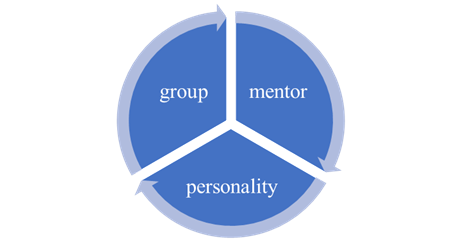
Various ways, methods, and forms of influence, both purposeful and spontaneous can be implemented. mentors, by their own example, influence the young people`s personality in the group through individual forms of interaction with them, and with this, the need for a “significant adult” is provided in situations of collective creative work, the mentors’ support and faith are undeniably relevant. The group influences each member and the mentor through the achievement of common goals, team victories and group support for everyone in the group. Obviously, each individual affects the group with his/her own behavior, judgments, emotions and value position.
For six years (2016-2022), a targeted intervention to enhance young people’s development based on a blend of psychological and pedagogical methods has been implemented as part of the recreation program "Children's Camp Zefir ". 2022 teens participated in the study based on the competency-based approach to working with young people as the main tool for actualizing the psychological potential of their personality.
Purpose of the Study
The actualization model operating on the transformational interaction cycle based on the competence approach was implemented for actualizing the psychological potential of young people’s personality in temporary groups.
The basic principles underlying this model are based on an individual-psychological approach to the young people’s development in conjunction with social group values comprising young people, adults and a temporary difference in age group.
Research Methodology
Primary diagnostic toolkit
The diagnostic toolkit consists of the following techniques:
1) Sociometric survey by Moreno, J. (Zlobina, 2007);
2) "Emotional intelligence" diagnosis by Hall, N. (Fetyskin et al., 2002);
This toolkit assesses the level of young people’s potential psychological development by looking at key competencies as cooperation, communication, cross-cultural intelligence, service leadership and social-emotional intelligence. These are basic competencies underlying the effective development of the personality in the group, preserving its individuality and authenticity.
Statistical measurements were taken during 6 years of planned systematic work in accordance with the teenager`s psychological potential developing technology (Svatenkova & Svatenkov, 2021). Testing started on the second day after arrival at the camps and ended on the last day (11 or 12 days) of the camp (see Figure 2).
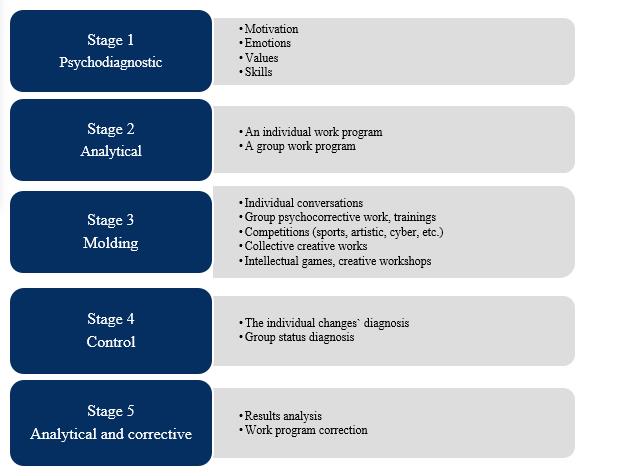
Participants
Participants: 2022 children aged 12-16 took part in the study on the basis of anonymity and voluntariness; children's participation is agreed with parents in writing; the main criterion for participation in the study was the child's age.
During the first year of the implementation, an optimal training rapid adaptation program was formed based on the diagnostic data leading to the enhancement and correction of the emotional intelligence level and the participants’ key competences optimization. The program comprised 3 lessons of 9 hours (3 hours each) conducted in the first three days of the participants’ being in a new team. In addition to the training, individual consultations with the psychologist (based on the results of the methodology) were conducted and the optimal group interactions were selected based on the general group emotional intelligence level and test results.
Stages of the implementation of the program
- Psychodiagnostic - where the psychological characteristics of each participant were tested using the above toolkit on the first day of the implementation.
- Аnalytical - age-appropriate psychological exercises and tasks were selected to evaluate psychological characteristics. These were analyzed to generate psychological and pedagogical recommendations for individualized work with each participant and in group interaction.
- Мolding - Throughout the period of the implementation of the model, the mentors, together with the psychologist, worked in the teams providing individual counseling with the participants, using exercises on creativity development, guiding cohesion, and increasing communicative and emotional competence through mutual support.
- Сontrol – the psychological characteristics were evaluated using the toolkit on the final day of testing to gauge the quality of the work performed.
- Аnalytical and correctional – the control analysis was used to revise and enhance the intervention program.
Sociometric testing was selected as the main diagnostic method as it allows for the immediate evaluation of each participant’s sociometric status in a new team, their likes and dislikes, and the identification of leaders and outsiders. According to Goleman (2020), the emotional intelligence level has a decisive influence on individuals’ adaptability level and quality of social contacts in a team. The results of this diagnosis allow for the formulation of the plan to work with the team and the individual. A total of five years was spent to collect results on working with age specific young people comprising 55 periods of young people’s in temporary groups.
Goleman’s emotional intelligence model supported the development of all five components in the intervention program while a separate component of self-awareness was developed in the participants’ individual work with the mentor accompanied by a psychologist. It is in group performances that young people’s self-control of emotions, self-motivation, empathy and the range of communication skills can be developed and expanded; hence, the inclusion of forum theaters and psychodramatic productions in the program.
Separately, non-age specific specially created socio-psychological day long games (based on the game “Mafia”), helped motivate the participants to control their emotions, identify and recognize the emotional state of others, while stimulating the participants’ communication skills development in a team. Using cooperation and interaction, observation, and identifying verbal and non-verbal communication cues, young people can develop emotional intelligence, communicative competence, general intelligence and empathy. This optimizes the motivational component of the psychological potential actualization which allows young people to manage their own behavior and predict the environment’s behavior, as well as expand and deepen the value orientations of the individual – all this develops young people’s personality and actualizes and increases their psychological potential.
Daily joint group dialogues – the day`s summaries - reveal the participants’ potential. These dialogues are held in a comfortable, conducive manner, where everyone is given the opportunity to be heard and not judged. An experienced specialist-mentor skillfully manages the conversation process and motivates the expression of emotions, provides guidance on how to recognize and identify one`s own emotions and that of others and express them according to the situation. This enables young people to enhance their own emotional intelligence level and get the opportunity to reveal their abilities and talents in the group.
Results
The results of the first intervention according to the sociometric test indicators revealed:
- 667 children out of 2022 had a low sociometric status (33%); 788 were satisfactory and within the norm (39%), 303 were above average (15%), and only 263 had a high sociometric status (13%).
- According to the emotional intelligence level indicators (integrative level), 1051 respondents had a low emotional intelligence level (52%); 748 have an average level (37%) and only 222 respondents had a high emotional intelligence level (11%).
Systematic planned work with the participants was carried out every day and significant changes were observed:
i. only 242 children had unsatisfactory (below the norm) sociometric status in the group (12%); 506 – satisfactory and average (25%); 809 – above average (40%) and 465 – high sociometric status (23%) (Figure 3).
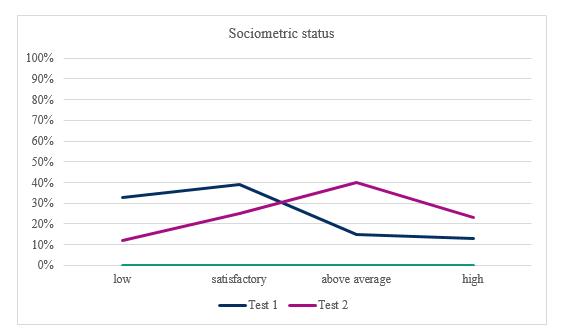
ii. Positive changes were found in the emotional intelligence level (integrative level): only 505 respondents remained with a low emotional intelligence level (25%); 1051 developed an average emotional intelligence level (52%) and 465 had a high emotional intelligence level (23%) (Figure 4).
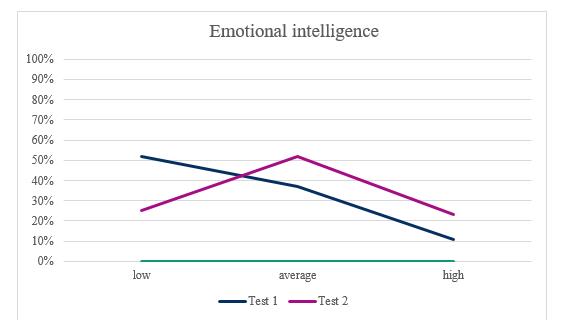
It is worth paying attention to the fact that in both graphs the Test 1indicators show the test results values on the diagnostic stage of work, and the Test 2indicators show the testing results on the control stage of work according to the teenager`s psychological potential developing technology.
An effective psychocorrective program for actualizing the adolescents` psychological potential was developed and implemented in view of the research results. Thanks to the coordinated work of specially trained specialists and a pre-developed program, the need to acquire life skills and a sense of maturity in a temporary children's group is formed. This happens due to the several important factors interaction:
- The specialist and mentor`s authority, his behavior, the personally style of interaction with the child and with the group leads to the identification process activation with a child`s significant adult, there is a desire to be like him, to imitate him. This is very relevant in adolescence, when the parents` role is leveled and the individual is in the searching process for a new model for identification, which often leads to the behavior`s deviant forms choice through identification with correspondingly antisocial personalities.
- Unique opportunities for each child`s self-realization are created with the help of effectively selected methods working with a child and a children group, taking into account individual abilities, preferences and competence development level. The child's self-realization activated process within the competence approach in working with a temporary children's group makes it necessary to continue this process outside the camp. The motivation for self-change and the need for self-realization within the similar system framework is formed. Since there is still no system similar to ours in the educational environment, the children strive to return to the camp or continue the self-realization`s and adulthood`s mastery process through the key competencies` assimilation within the psychocorrective program.
- The Zefir `s camp work specifics provide for the no more than 80 children staying for one recreation period (12 days). All activities are based on the children`s active interpersonal interaction principles in different ages mixed groups. The teenagers` need to show an independence and responsibility sense is realized – they help the younger ones to self-organize and interact as a single group for the completing a task or participating in a game period. In this way, we instill in children the motivation to grow up, activate the need to grow up and change, the need to master new skills and competencies.
- A teenager's basic need for recognition is realized through independent active participation in individual and group sports, creative, socio-psychological work forms. In addition, obtaining recognition is clearly regulated by the rules in each form of work and within the relevant competencies` framework. The individual's success further recognition prospect is transferred to the child's social life.
- The adult`s role initial testing and the adolescents` psychological potential actualization also takes place in temporary groups through attempts at mentoring, carrying out assignments, leadership and helping older mentors. This encourages the teenager to develop and master the adult`s role not only within the camp`s shift framework, but also in social life.
The adolescence`s outlined above features, the requirements for building an educational environment, and the modern scientists` works regarding the competence approach formed the personal development training program basis developed by us. In particular, thanks to the adaptation`s processes actualization, self-development, important social skills acquisition during trainings, which involve all group members interaction with the gaining positive experience aim, forming certain skills and solving problem situations, adolescents develop such competencies as: cross-cultural intelligence and self-expression, the group interaction`s basics, critical thinking, communication skills, leadership and mentoring, social-emotional intelligence; the media literacy and computational thinking foundations, independent continuous learning are laid in classes on time management and life path planning.
Particular attention was paid to the adolescent's psychological potential main components development level (motivational, emotional, value and behavioral). The psychological potential actualization program correction was based on these data and taking into account the potential capabilities of each child, according to the immediate development zone.
At the same time, in 2021-2022, teenagers from various schools of the country took the same tests on the anonymity and voluntariness basis. The control group includes 122 teenagers. The measurements results are shown in figure 5 and 6. Accordingly, the first graph shows the results of preliminary testing in both groups (experimental and control). In the percentage ratio, we have the results marked "normal" and "above normal". Experimental group pre-testing method 1 – 20%, method 2 – 21%. The control group of method 1 – 20%, method 2 – 22%. It can be seen that the indicators are almost at the same values.
Preliminary and control testing`s comparison graphs in experimental and control groups
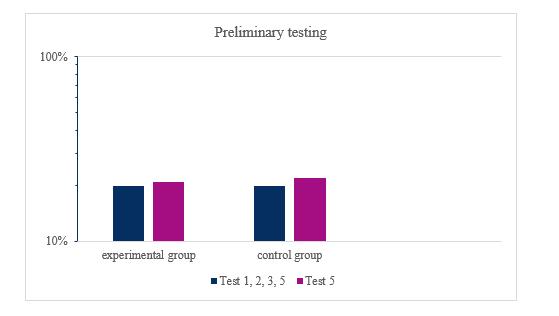
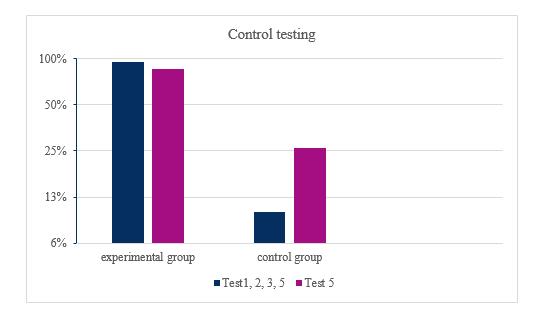
Control testing showed that teenagers who went through the psychological potential actualization using the technology described above and in the recreational restorative environment in the "Zefir Children's Camp" recreation program showed very good results: their emotional intelligence increased significantly, motivation, value orientation indicators.
The fact of the individual`s psychological potential dynamic growth within the framework of purposeful socio-psychological influence through cyclical training program is obvious. It is important to note that a psychological and social-pedagogical specialist participated in the program`s preparation and conducting the classes, which also helped to interact holistically and effectively with the group and form relevant competences for today.
Result: The teenagers’ psychological potential actualizing program is effective.
Taking into account David Yun Dai's concept about the adaptive efforts` role in the individual's potential development, the thesis about the endogenous and exogenous forces` interaction nature that motivate and direct the individual`s psychological potential development is important. The author defends the opinion that on the way to the individual's potential development there are environmental opportunities and limitations on the one hand, and the individual's actions sociocultural mediation (tools, values, etc.) on the other. The teenager's personality development causes him a need that has adaptive consequences. This socio-cultural pressure situation provides certain opportunities to learn, develop, control, get pleasure, satisfy needs, but at the same time sets limits and conditions (i.e., challenges) for the opportunities` materialization. The nature of such a transaction between the individual and the environment determines that the psychological potential is not innate, but the result of self-organized and self-directed adaptive reactions to the environment`s opportunities and challenges. Abilities and dispositions, presumably partially genetically determined, are developed and used to enhance performance in the core domains of human functioning (intellectual, creative, technical, social, and psychomotor (Dai & Li, 2020.) to meet needs and achieve desired goals. One might refer to such conditions as a metaphorical "push" to denote this awakening and satisfying needs process.
The conditions for the adolescent's psychological potential actualization are described in advance. It is important to characterize the processes taking place in the adolescent's inner personal space, their external manifestation specifics at the psychological potential`s components level. Exactly what psychosocial formations form external psychosocial necessity, internal potential readiness and the need for subject dialogicity at the level of motivational, value, emotional, behavioral components and self-image (Figure 7).
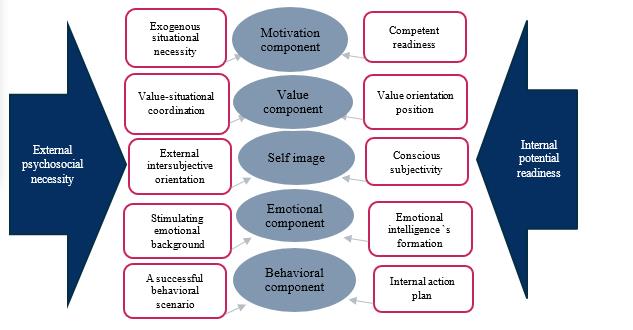
This model depicts the adolescent's psychological potential actualization conditions` situation in component's readiness view, the psychological potential "maturity" for manifestation in the relevant situation and relevant circumstances (be it a creative role, a leadership position, intellectual achievements, etc.). These psychosocial formations dynamics can be described more specifically as follows:
Motivational component:
- characterizes the individual`s internal conscious position regarding the direction and nature of his own psychological potential`s manifestation (I am aware of my strengths and wish to manifest them);
- has an external urgent need to act in the given circumstances in order to achieve a goal supported by a reference group or person.
Value component:
- the situation is determined by the values relevant to the individual;
- the final result has a value-oriented justification (or terminal value).
Emotional component:
- emotional intelligence must be at or above the age level that the situation requires of the individual;
- the emotional background of the situation should encourage action and support the individual.
Behavioral component:
- the individual must develop his own internal action plan in this situation;
- in the individual`s experience (own or borrowed) there should be a scenario of successful behavior in similar situations.
should be characterized by a dialogic position in this situation: on the one hand, the individual has a formed subject position in relation to himself in the surrounding world, on the other hand, he is in the process of acquiring and forming the experience of external intersubjective interaction.
Discussion
Scientific achievements after Galton (1869) significantly changed the view of psychological potential with a fixed ability. For example, IQ as a measure of "general intelligence" is no longer interpreted as a genetically determined ability but is seen as the result of the genes interaction and environment (for example, the concept of the "response range" of genetic manifestations, depending on whether the environment is limited, natural or enriched;) (Bouchard, 1997). Rose (2016) recently questioned the assumption of a normal distribution of human traits; he argued that the wealth of psychological potential comes from a largely neglected, seemingly unlikely source: the "unevenness" of personal profiles.
Although Galton (1869) pointed to the importance of motivation (diligence and hard work) in the psychological potential realization, a purely genetic explanation of motivation is not viable in light of the research evidence preponderance. Rather, motivation such as intrinsic interest (Gottfried & Gottfried, 2004) or commitment to a task (Renzulli, 1986) is contextually and developmentally shaped. If this is so, the psychological potential of adolescents cannot be considered as a constant quality, but as a variable and dynamic one.
Expert research has found that long periods of learning and focused practice not only lead to improved skills, but also activate relevant genes and cause structural and functional changes at the neuronal level (Schlaug, 2001). In addition, new pedagogy and technologies also significantly expand the boundaries of actualizing the individual`s psychological potential in adolescence (Anders Ericsson et al., 2007). The adolescent's psychological potential is no longer solely explained by endogenous factors but is related to the educational resources available for skill development (Vialle & Ziegler, 2016). Dependence on resources and tools reconstructs the utilitarian perception of psychological potential into a more situational concept of the adolescent's psychological potential as a rhizomorphic multiplicity of the distribution of variable potentials between the individual, the task, and available resources and tools.
Conclusions
Internal potential readiness involves the individual`s psychological potential at the competent formation level in accordance with age, sociocultural and situational requirements. External psychosocial necessity, in turn, is in a certain way provocative circumstances that actualize the need to manifest the individual`s psychological potential.
Adolescent's psychological potential actualization requires purposeful, organized actions on the adult`s part and internal needs on the adolescent`s part. In the children's recreation program "Zefir" and the psychological club "Alternative" we have been studying this process since 2016, and now the checking and correcting methods procedure according to the teenagers` needs and today's challenges is underway. Based on the work`s results, the teenagers` stories-narratives hermeneutic research regarding the potential and the tests` results, the teenager`s psychological potential actualization complex model was created (Figure 8).
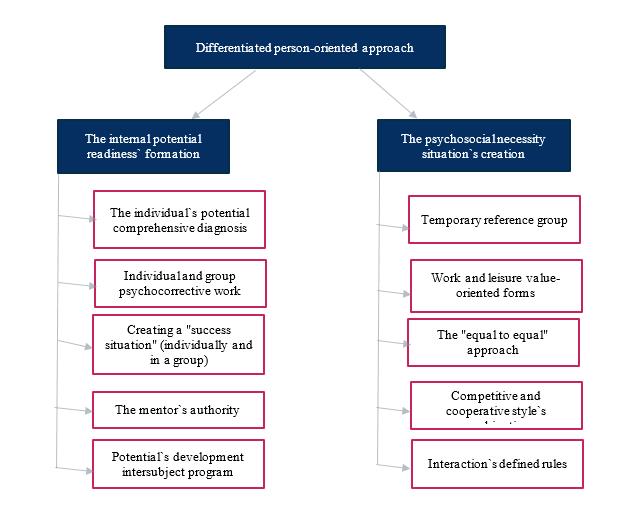
The teenager`s psychological potential can be actualized thanks to the teenager`s motivation and perseverance, it can be actualized in the educational environment at school (if it corresponds to the individual`s interests and desires), in the peer group and in other situations. In our work, we aimed to create a model that will not only help one-time and situational self-expression, but will help form a sense of competence, confidence in one's own abilities and the desire to acquire potential and use it for one's own development and self-realization in a teenager.
That is why we use a differentiated approach to the individual in our work, diagnose the everyone's psychological potential components formation level, abilities and needs, adjust the leisure program and psychological work with a group and individually. Accordingly, the model of leisure and educational work with teenagers is also changing: the leisure recreation environment is limited to 70-80 children per stay (Zefir Children's Camp recreation program), and the educational psycho-corrective environment is limited to 10-15 children at a time (psychological club "Alternative" and trainings in the camp). Appropriately trained specialists (with appropriate education) are selected to ensure the tasks` fullest possible implementation (including the adolescents` psychological potential actualization).
This model takes into account all previous approaches and modern challenges regarding the teenager's personality development. In our program, we try to purposefully shape the teenager`s potential readiness to express himself and use his own potential. Throughout the child's stay, we "accompany" the teenager, so to speak:
- we select an approach to the child according to the diagnosis results;
- form a work program according to needs and possibilities;
- we create a potential`s successful manifestation situation in the appropriate direction (sports, creativity, intelligence, e-sports, interpersonal communication, teamwork, leadership, etc.);
- trained mentors become authoritative reference adults for program participants, support and encourage children;
- we create temporary reference groups according to the participants` age and preferences at the beginning of the program;
- choice`s variability and freedom in attending master classes provide an opportunity to test one's potential in different directions and choose the one that best suits the individual;
- individual and group work forms are related to the participants` values (which are previously clarified in the diagnosis);
- the "equal to equal" approach makes it possible to feel important and competent, to become a mentor and assistant in working with smaller participants of the program (which ensures the need for subject dialogicity realization);
- the competitive and cooperative approaches combination in various forms of work creates a certain psychological pressure and the excitement situation, which provokes to try oneself in different roles, without feeling judgment and pressure;
defined rules of group and interpersonal interaction serve as guidelines in determining the behavior`s style and achieving the desired results.
Acknowledgments
The research was carried out at my own expense. Children's camp "Zefir" is a joint project of our family. I want to thank my husband Oleksandr Svatenkov for his support and faith in our project. Thanks to all the parents who have trusted us with their children for the sixth year.
References
Anders Ericsson, K., Roring, R. W., & Nandagopal, K. (2007). Giftedness and evidence for reproducibly superior performance: an account based on the expert performance framework. High Ability Studies, 18(1), 3-56. DOI:
Bauerlein, M. (2022). The Dumbest Generation Grows Up: From Stupefied Youths to Dangerous Adults. Regnery Gateway. DOI: 10.1007/s12129-009-9102-1
Bouchard Jr, T. J. (1997). Experience producing drive theory: How genes drive experience and shape personality. Acta Paediatrica, 86(S422), 60-64. DOI:
Dai, D. Y., Li, X. (2020). Behind an accelerated STEM research career: Dynamic interplay of endogenous and exogenous forces in talent development – Department of Educational and Counseling Psychology, University at Albany, Albany, NY 12222, USA – Educ. Sci., 10(9), 220; DOI:
Fetyskin, N. P., Kozlov, V. V., & Manuylov, H. M. (2002). Diagnostics of "emotional intelligence". In N. Hall (Ed.), Social and psychological diagnosis of personality development and small groups (pp. 57-59). Publishing Psychotherapy Institute House.
Galton, F. (1869). Hereditary Genius : an Inquiry into Its Laws and Consequences. Macmillan.
Goleman, D. (2020). Emotional Intelligence (25th Anniversary Edition). Bloomsbury.
Gottfried, A. E., & Gottfried, A. W. (2004). Toward the development of a conceptualization of gifted motivation. Gifted Child Quarterly, 48(2), 121–132. DOI:
Renzulli, J. S. (1986). The three-ring conception of giftedness: A developmental model for creative productivity. In R. J. Sternberg, & J. E. Davidson (Eds.), Conceptions of giftedness (pp. 53–92). Cambridge University Press.
Rose, T. (2016). The end of average: How we succeed in a world that values sameness. HarperOne.
Schlaug, G. (2001). The brain of musicians: A model for functional and structural adaptation. In R. J. Zatorre, & I. Peretz (Eds.), The biological foundations of music (Vol. 930, pp. 281–299). New York Academy of Sciences. DOI:
Smith, C. (2005). Servant leadership: the leadership theory of Robert K. Greenleaf. The Greenleaf Centre for Servant-Leadership UK (2005). Retrieved on November 12, 2005 from http://www.greenleaf.org.uk/whatissl.html
Stein, J. (2013). «The Me Me Me Generation». TIME, May 20. https://time.com/247/millennials-the-me-me-me-generation/
Svatenkova, T. I., Svatenkov, A. V. (2021). Emotional Potential in the Children's Team. Wiadomości Lekarskie, 74(11), 2738-2742. DOI: 10.36740/wlek202111110
Vialle, W., & Ziegler, A. (2016). Gifted education in modern Asia: Analyses from a systemic perspective. In D. Y. Dai, & C.-C. Kuo (Eds.), Gifted education in Asia: Problems and prospects (pp. 273–291). Information Age.
Zlobina, O. (2007). Sociometry: the interpersonal relations study in a group. http://isoc.com.ua/assets/files/book/zlobina/zlobina_sociometriy.pdf
Copyright information

This work is licensed under a Creative Commons Attribution-NonCommercial-NoDerivatives 4.0 International License.


